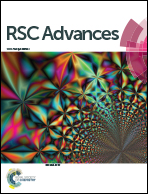A ZnO nanowire/PANIPAM hybrid energy converter driven by temperature oscillation†
Abstract
An inorganic and organic hybrid energy converter consisting of a vertically aligned ZnO nanowire (NWs) array and poly-N-isopropylacrylamide (PNIPAM) was fabricated. The nanoconverter can generate electric power from the temperature oscillations of the environment. The generated voltage is up to 2.1 V and the peak power density is as high as 0.27 μW cm−2 when the nanodevice is cooled from room temperature to 8.4 °C. The effective energy conversion performance was attributed to the large deformation coefficient of PNIPAM under cooling stimulation and the piezoelectric effects of ZnO NWs. This work provides an efficient route for the use of alternate energy sources in the environment.


 Please wait while we load your content...
Please wait while we load your content...